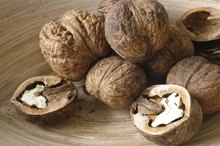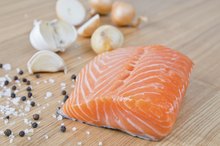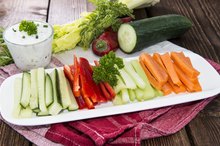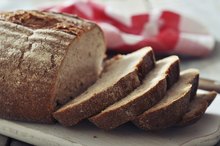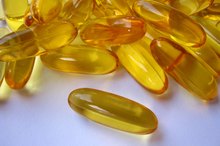What does fact checked mean?
At Healthfully, we strive to deliver objective content that is accurate and up-to-date. Our team periodically reviews articles in order to ensure content quality. The sources cited below consist of evidence from peer-reviewed journals, prominent medical organizations, academic associations, and government data.
The information contained on this site is for informational purposes only, and should not be used as a substitute for the advice of a professional health care provider. Please check with the appropriate physician regarding health questions and concerns. Although we strive to deliver accurate and up-to-date information, no guarantee to that effect is made.
Vitamin E & Constipation
Vitamin E is an antioxidant that encourages healthy red blood cells and may benefit the body's immune function. Antioxidant-rich diets may lower the risk of heart disease and some cancers, according to the Mayo Clinic. While constipation relief isn’t listed as a potential benefit of vitamin E by the Office of Dietary Supplements, vitamin E is found in many fiber-rich foods that are known to promote bowel movements 12.
Constipation
Constipation is typically defined as having fewer than 3 bowel movements per week, reports Medline Plus 1. Irregularity is usually associated with hard and/or painful stools or being unable to have a bowel movement after pushing or straining for longer than 10 minutes. Getting an adequate amount of fiber in your diet, defined as 20 g to 35 g daily, can help prevent constipation 1.
Dosing
Walnuts and Constipation
Learn More
The recommended daily allowance or RDA of vitamin E is 15 mg or 22.5 IU for men or women over age 14.
Considerations
Broccoli, almonds, sunflower and whole wheat bread are also excellent sources of fiber. Drinking plenty of water along with dietary fiber will help pass the stool more quickly. Regular exercise can also help ease constipation 1.
Precautions
Is Constipation a Side Effect of Vitamin D?
Learn More
Taking high doses of vitamin E supplements can increase the risk of bleeding, cautions the Office of Dietary Supplements 2. While rare, vitamin E deficiency can weaken the immune system and damage nerves and muscle that can cause:
- loss of feeling in the arms
- legs.The tolerable upper limit dosage of vitamin E supplementation is 1,000 mg or 1,500 IU daily for adults older than 18
- according to the U.S
Institute of Medicine.
Related Articles
References
- Medline Plus: Constipation
- Office of Dietary Supplements: Vitamin E
- Mayo Clinic: High Fiber Foods
- Institute of Medicine (US) Committee to Review Dietary Reference Intakes for Vitamin D and Calcium; Ross AC, Taylor CL, Yaktine AL, et al., editors. Overview of vitamin D. 2011.
- Abdel raheem A, Alowidah I. A commentary on "Optimal management of large proximal ureteral stones (>10mm): A systematic review and meta-analysis of 12 randomized controlled trials" (International Journal of surgery. 2020 July, https://doi.org/10.1016/j.ijsu.2020.06.025). Int J Surg. 2020;83:218-219.
- Laird E, Ward M, McSorley E, Strain JJ, Wallace J. Vitamin D and bone health: potential mechanisms. Nutrients. 2010;2(7):693-724. doi:10.3390/nu2070693
- Aranow C. Vitamin D and the immune system. J Investig Med. 2011;59(6):881-886. doi:10.2310/JIM.0b013e31821b8755
- Penckofer S, Kouba J, Byrn M, Estwing Ferrans C. Vitamin D and depression: Where is all the sunshine?. Issues Ment Health Nurs. 2010;31(6):385-393. doi:10.3109/01612840903437657
- Legarth C, Grimm D, Wehland M, Bauer J, Krüger M. The impact of vitamin D in the treatment of essential hypertension. Int J Mol Sci. 2018;19(2):455. doi:10.3390/ijms19020455
- Mason C, Xiao L, Imayama I, et al. Vitamin D3 supplementation during weight loss: a double-blind randomized controlled trial [published correction appears in Am J Clin Nutr. 2014 Oct;100(4):1213]. Am J Clin Nutr. 2014;99(5):1015-1025. doi:10.3945/ajcn.113.073734
- Harvard Health. How much vitamin D do you need? 2020.
- Sahota O. Understanding vitamin D deficiency. Age Ageing. 2014;43(5):589-591. doi:10.1093/ageing/afu104
Writer Bio
Karen Hellesvig-Gaskell is a broadcast journalist who began writing professionally in 1980. Her writing focuses on parenting and health, and has appeared in “Spirituality & Health Magazine" and “Essential Wellness.” Hellesvig-Gaskell has worked with autistic children at the Fraser School in Minneapolis and as a child care assistant for toddlers and preschoolers at the International School of Minnesota, Eden Prairie.
